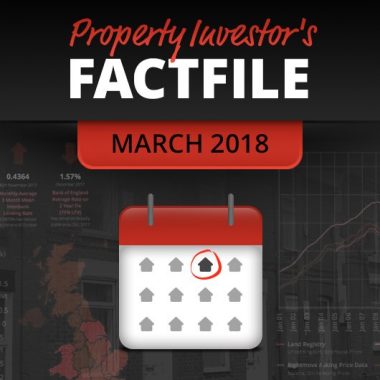March 2018 Property Investor´s Factfile
The Property Investor’s Factfile presents a range of relevant data from national / London house prices, the latest buy-to-let Limited Company (SPV) loan rates, LIBOR / SWAP rates and rentals to mortgage debt figures and information on the first-time buyer sector. Below are some noteworthy observations over the last month:
Property Market Trends
- According to the Halifax, property prices are rising at their slowest rate since 2013 – growing by 1.8% in the three months to February. Managing director Russell Galley, nonetheless, responded with some relatively positive feedback on the data: “While we expect price growth to remain low, the low mortgage rate environment, combined with an ongoing shortage of properties for sale, should continue to support house prices over the coming months”;
- Nationwide data reported that house prices fell 0.3% between January and February (after rising 0.2% in the previous month). Prices increased by 2.2% in the 12 months to February. Chief Economist, Robert Gardiner commented that: “month-to-month changes can be volatile, but the slowdown is consistent with signs of softening in the household sector in recent months”. Moving forward, Gardiner expects house prices to be “broadly flat, with a marginal gain of around 1 per cent over the course of 2018” (representing a fall in real terms);
- According to the Royal Institute of Chartered Surveyors (RICS), the number of properties on estate agents’ books has fallen to new lows. The average agent has 42 properties per branch (in London the figure currently lies at 33). The data also reported that, for the eleventh consecutive month, the number of new buyer enquiries fell. Buyer demand has fallen the most in London, but increased in in Scotland, Northern Ireland and Yorkshire and the Humber. Expecting house prices across the UK to grow by 15% by the end of 2023, Simon Rubinsohn, chief economist at RICS commented that: “the divergent regional picture is becoming increasingly pronounced with key indicators across huge swathes of the country still showing considerable resilience, but data for London, the south east and East Anglia are rather more subdued”;
- Rightmove highlighted a number of “fast-growing” areas across the UK in descending order: Newport (Wales), Oldham (North West), Scunthorpe (Yorkshire and the Humber), Rochdale (North West), Leigh (North West), Wrexham (Wales), Southport (North West), Colwyn Bay (Wales), Dewsbury (Yorkshire and the Humber) and Birkenhead (North West);
- Other regional-specific data by Hometrack’s Cities House Price Index reported year-on-year growth (up to January 2018) in Edinburgh (8.2%), Birmingham (7.5%), Glasgow (7.2%), Manchester (7.0%), Nottingham (6.5%), Liverpool (6.1%), Bristol (6.1%), Leeds (6.1%), Bournemouth (5.8%), Leicester (5.6%), Belfast (5.5%) and Portsmouth (5.0%). Slowdowns in price growth were seen in Oxford (-0.9%), Cambridge (-1.4%) and Aberdeen (-9.9%);
- The global real estate services group Savills (listed on the London Stock Exchange) reported 2017 pre-tax profits rising by 12.6% to £112.4 million. According to the press release, Savills’ residential business has been relatively resilient in “challenging” conditions: “We have made a solid start to 2018 with a pipeline of business carried over from last year in many markets, although this is against the backdrop of heightened market uncertainty, geopolitical risks and rising interest rates. We anticipate some tempering of the strong transaction volumes of recent times in some markets; however, at this early stage in the year our expectations for 2018 remain unchanged”;
- Bearing in mind the 2-3 month time lapse for sold price registration, between December 2017 and January 2018, Land Registry reported 1.77% and 0.97% property price increases in the City of Westminster and the City of London respectively, an increase in Inner London [1] prices (1.06%) and a marginal decrease in Outer London [2] prices (-0.25%);
- This interactive map produced by Bloomberg tracks London’s property prices, median sale values, sales volumes and price changes (using Land Registry data);
- According to Acadata, average prices in London fell to £593,396 in January – representing an annual decline of 2.6%. Lucian Cook (@LucianCook), head of residential research at Savills, believed that the capital will be the worst performing market in the UK over the next five years. This, he believes, is due to over a decade of accelerated price growth relative to the rest of the country meaning that the city is more exposed to political and economic certainty, interest rate rises and mortgage controls. An increased tax burden on landlords, the National Crime Agency’s “dirty money clampdown” on overseas capital invested in property alongside the increasingly negative media sentiment are also collectively having an influence. The highest valued boroughs were most affected, with Wandsworth prices down by an estimated 15% over the last year;
- If you have not the chance to check it out, this excellent house price tool by the BBC (covering England and Wales) shows how real values (factoring in inflation) have performed since the Credit Crunch (thanks to @HenryPryor for sharing this resource on Twitter).
Rental Market Observations
- The most recent HomeLet Rental Index report indicated that average rents across the UK rose by 1.2% in February 2018 relative to February 2018 (average monthly rents are now £906). According to the data, average London rents are at £1,537 per month – increasing by 1.1% in February 2018 compared the same month in 2017. Excluding London, the average UK rental value was £758 in February 2018, up 2.3% on 2017. Homelet’s interactive infographic may be of use to observe some broader rental market trends;
- Your Move’s latest Buy-to-Let Index indicated that average rents are up 2.5% year-on-year in England and Wales. With average rents estimated at £829 per month, according to the data, London and the North East saw a price fall and yield levels have stablised at the start of the year;
- For the 12 months up to February 2018, Landbay’s Rent Check reported increased rental values in Edinburgh City (4.6%), Leicester (3.4%), Nottingham (3.3%), Peterborough (3.0%), Bath and North East Somerset (2.8%), Ceredigion (2.7%), Northamptonshire (2.6%), West Dunbartonshire (2.6%), Isle of Anglesey (2.6%) and Bristol (2.4%). Rental value drops were seen in Aberdeen City (-6.5%), Aberdeenshire, (-5.6%), City of London (-2.1%), Kingston-upon-Thames (-1.8%), Windsor and Maindenhead (-1.4%), Kensington and Chelsea (-1.2%), Moray (-1.2%), Hackney (-1.2%), Richmond-upon-Thames (-0.9%) and Wandsworth (-0.8%);
- Please see other rental data and statistics in the RENTING section (page 2) of this months factfile.
Macro-Economic Conditions for Buy-to-Let Property Investors / Traders
- Office of National Statistics data reported that consumer price inflation fell to 2.7% (from 3% in January);
- Although not cracking down on lenders, the Bank of England has reported that it will be monitoring attitudes to risk in response to a rising amount of mortgages being granted at over four times borrowers incomes. Should the risk continue, banks could be forced to hold more capital which, in turn, could affect lending rates;
- UK Finance reported a spike in remortgage activity in January. In total there were 49,800 residential refinance agreements granted over the month – a 19.1% rise relative to January 2017. According to Jackie Bennett, UK Finance’s director of mortgages commented that: “Remortgaging in January reached a nine-year high, as a number of fixed-rate mortgages came to an end, while borrowers locked into attractive deals amid expectations of further interest rate rises.”
Buy-to-Let Investing / Financing Conditions
- The 3-Month London Interbank Offered Rate (LIBOR) rose from 0.54663 on 15th February to 0.60591 on the same date in March;
- Although the 1-year SWAP rate increased to 0.043 between Mid-February and Mid-March, the 5-year rate dropped by -0.122 points;
- According to Bank of England data, buy-to-let borrowing slowed to it’s lowest level since 2013. 12.7% of mortgages in the final quarter of 2017 were for buy-to-let purposes (compared to 14.7% over the same period in 2016 and 16.3% in 2015);
- Specialist lender Vida Homeloans has recently launched a new range of buy-to-let mortgages for credit-impaired borrowers. Those with County Court Judgements or other defaults in the last three years would not be able to access the loans. Rates are starting at 2.89% (up to 70% loan-to-value);
- Other SPV mortgage rates featured in this month’s property investor’s factfile include a Barclays fixed 2.69% pay rate until the end of January 2023 with a £1,950 arrangement fee (a similar product is available without the arrangement fee, but with a higher pay rate of 3.09%). The State Bank of India continues to offer a 5-year SPV mortgage with a 3.24% tracker pay rate and a £937 loan fee. For more information and to discuss your specific borrowing circumstances please get in touch with paul.lowcock@bespokefinance.info or direct on 01133 203240;
- The BM Solutions’ full rental income calculator checks the eligibility for buy-to-let loans prior to submitting a case. To see the results, enter the number of applicants, type, income, product rate, term length, maximum loan to value, property value, loan required and anticipated monthly rental income. Note the disclaimer that the calculations are for illustrative purposes only and do not represent a full mortgage offer;
- Please see our recent post on mortgage underwriting (within the buy-to-let sector) for some insights into the key influences of buy-to-let mortgage payrates.
Housebuilding and Affordable Housing
- According to UK Finance, 24,500 buyers got on to the housing ladder in January 2018 – the highest figure since 2007. Although Chancellor of the Exchequor Philip Hammond affirmed that 60,000 buyers have benefitted from the Stamp Duty break introduced in the Autumn Budget, whether this growth trend will continue over the course of 2018 remains to be seen;
- The Resolution Foundation raised its concerns over a “ticking time bomb” for families who hold Help to Buy loans. From April 2018, up to 2,000 homebuyers will begin to pay additional fees in addition to ongoing mortgage costs. Referred to in some property circles as another form of sub-prime lending, the think tank commented to the FT that the fees on these loans could trigger a “double whammy hit” to borrowers when combined with potential interest rate rises over 2018;
- A Guardian Cities investigation reported that the housing affordability crisis is spreading to other parts of the country. In Manchester, for example, none of the 14,667 homes in the large developments granted planning permission in the last 2 years are affordable using the government’s own definition. In Nottingham, 3.8% of housing units that have been granted planning permission meet the criteria. Guardian data also demonstrated that just 6.77% of new developments in Bristol city will be affordable. However, on a relatively positive note, Cardiff saw 24% of the homes being granted permission between 2016 and 2017 meeting the affordable definition.
Please feel free to follow us on Twitter and receive regular updates of relevance to property investors via our Facebook page. If you have not already, we would also encourage you to subscribe to our monthly e-bulletin (and receive our latest e-book and comprehensive buy-to-let financial calculator). Please click on the animation below for more information and to fill in your details in the “PLEASE LEAVE YOUR DETAILS HERE” box.
[1] The Land Registry classifies Inner London as constituting the following boroughs: Camden, City of London, Hackney, Hammersmith & Fulham, Haringey, Islington, Kensington and Chelsea, Lambeth, Lewisham, Newham, Southwark, Tower Hamlets, Wandsworth and Westminster.
[2] Informally referred to as the “donut” areas of London: Barking & Dagenham, Barnet, Bexley, Brent, Bromley, Croydon, Ealing, Enfield, Greenwich, Harrow, Havering, Hillingdon, Hounslow, Kingston upon Thames, Merton, Redbridge, Richmond on Thames, Sutton and Waltham Forest.










